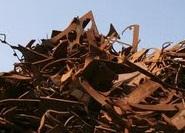Prices

January 10, 2016
Ferrous Scrap Wrap Up First Week of January 2016
We are pleased to have Philip Hoffman, Chairman & CEO of Hoffman Iron & Steel provide us his unique insights on both the domestic and international scrap markets as well as his forecast for where international and domestic scrap prices will be headed in the next month or two (and why).
As most are aware, US ferrous scrap prices for Jan settled up $20; some more, some less, depending on regional factors. So let’s start with the export market and work our way back to the US market.
The latest US bulk cargoes to Turkey were booked at 192.50 for HMS (heavy melt scrap) from the US East Coast and 193.50 from Florida which puts the FOB loaded vessel price at 175.50/MT minus $25 for yard and loading costs. This means that to break even exporter yards can pay 155.50/MT (158/GT) for 80/20 HMS from dealers. We all know that exporters don’t want to just break even, so they are paying between 130-140/GT to large dealers to compete with east coast domestic scrap consumers who are paying 160/GT for 90/10 HMS rather then the 80/20 export grade. Dealers are seeing an almost halt to the peddler scrap trade because at 50-60/GT few peddlers can make money picking up scrap at those levels. Most dealer yards have little inventory and auto wreckers are holding scrap cars for parts at these price levels. As a result of these factors, scrap flow to the export yards is slow.
On the other side of the Atlantic Turkish mills have played a wait and see game by staying out of the market in the last half of November and the month of December hoping to push prices down from their high of 200-203/MT CFR in Mid November. It worked only minimally because, despite falling prices for rebar in Turkey, mills are now short scrap and have to come back to the bulk scrap market this or next week.
In the Pacific, China attempted to raise billet prices to 260-265/MT CFR Turkey in December with few takers – now price offers are being made at 257/MT and traders are pushing Turkish mills to take them. The problem is Chinese billet can only be delivered by March and the Turks need the billets by late Jan/Feb to fill their orders. As such, the Turks are between a rock and a hard place – they need to melt to service both their export and domestic customers and Chinese and CIS (Eastern European) billets can’t bail them out. As to the future for Chinese billets, the recent Yuan devaluation has increased iron ore prices in Yuan terms and thus the Chinese are also between a rock and a hard place – with the Turks showing no interest at higher prices and iron ore rising Chinese mills look to be seeing more red.
Export Price Prediction:
Due to slow in-bounds into export yards in the US, low scrap inventories in Turkey and a lack of prompt Chinese/CIS billet expect to see scrap export prices increase to above $200/MT CFR Turkey in the coming weeks. Cargoes will be purchased for Jan/Feb shipment and the docks will have to increase prices to fill those orders.
US Domestic Scrap Prices:
Chicago shredded at 190/GTD – HMS 170 – Up $30 for shred and $20 for HMS
Detroit at 190/GTD shredded – HMS 170 – Up $20 for both
Ohio Valley 195-200 Shredded – HMS 170-175 Up $20 for both
East Coast mills – 185 – 190 Shredded – 160HMS up $5 -10 for both
Alabama SSAB – and Southeast Nucor – 220 shredded HMS 195 – 200 up $20 for both
Commentary:
Many predict that, because of the need for restocking due to end year scrap inventories being reduced and a capacity utilization rate of 60 percent, the January scrap price increase is going to be short lived. Factors that go against that market chatter is that, due to the dramatic price decrease and lack of financial incentive, scrap has simply dried up. This is certainly true of peddler and auto wrecker scrap as previously discussed. The issue is industrial scrap – with cars selling at a record 17.1 million units there is a lot of busheling and bundles being produced; not to mention that Nucor is set to finally restart their Louisiana DRI plant.
Conclusion:
There is no doubt that peddler and auto wrecker scrap flows are off significantly. That coupled with increased export demand makes the January price increase have sustained legs into February at least for the coastal regions in the east and southeast. For the Midwest the water is muddy due to the availability of industrial scrap (if the pure metals mess is cleaned up) and if Nucor’s DRI start up is successful. As such, in the Midwest regions busheling may drop due to its availability but shredded and cut grades will likely move sideways despite low capacity utilization rates.
SMU would like your opinion as to the quality of the content provided above and if this is something you would like to see more of in our newsletter. Please send your comments to: John@SteelMarketUpdate.com or contact me by phone at 800-432-3475






